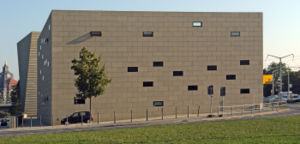.gif)
New Synagogue (Dresden)
Encyclopedia


Dresden
Dresden is the capital city of the Free State of Saxony in Germany. It is situated in a valley on the River Elbe, near the Czech border. The Dresden conurbation is part of the Saxon Triangle metropolitan area....
was completed in 2001 and designed by architects Rena Wandel-Hoefer and Wolfgang Lorch. It was built on the same location as the Semper Synagogue
Semper Synagogue
Semper Synagogue, also known as the Dresden Synagogue, was built in 1838-40 for the Jewish community of Dresden by Gottfried Semper. It was an early example of the Moorish Revival style of synagogue architecture. The Semper was the first synagogue to feature the richly ornamented interior that...
(1839–1840) designed by Gottfried Semper
Gottfried Semper
Gottfried Semper was a German architect, art critic, and professor of architecture, who designed and built the Semper Opera House in Dresden between 1838 and 1841. In 1849 he took part in the May Uprising in Dresden and was put on the government's wanted list. Semper fled first to Zürich and later...
, which was destroyed in 1938, during the Kristallnacht
Kristallnacht
Kristallnacht, also referred to as the Night of Broken Glass, and also Reichskristallnacht, Pogromnacht, and Novemberpogrome, was a pogrom or series of attacks against Jews throughout Nazi Germany and parts of Austria on 9–10 November 1938.Jewish homes were ransacked, as were shops, towns and...
.
The boundary wall of the New Synagogue incorporates the last remaining fragments of Semper's original building. The outer walls of the synagogue are built slightly off plumb, intended by the architect to convey the feeling that the Jewish community has always been slightly set off from the German city. The synagogue is also an interesting contrast to the city center with which it is juxtaposed. It is set on a slight rise just at the edge of Dresden's baroque
Baroque
The Baroque is a period and the style that used exaggerated motion and clear, easily interpreted detail to produce drama, tension, exuberance, and grandeur in sculpture, painting, literature, dance, and music...
center, which was completely flattened by allied bombing during the war. The center is being rebuilt with buildings whose exteriors (and in the case of the more significant buildings, also interiors, though not construction materials,) are precise replicas of the baroque royal city that long made Dresden famous. The synagogue stands beside this careful reproduction of the past, but it is not a replica of the historic Semper Synagogue
Semper Synagogue
Semper Synagogue, also known as the Dresden Synagogue, was built in 1838-40 for the Jewish community of Dresden by Gottfried Semper. It was an early example of the Moorish Revival style of synagogue architecture. The Semper was the first synagogue to feature the richly ornamented interior that...
. It is a bold modernist statement that contrasts dramatically with its neighbors.
The interior space is equally dramatic. The sanctuary building is a cube (all service functions are located in the companion building set at the other end of a stone plaza.) Within this cube is set a square worship space, curtained off on all four sides by an enormous draping of curtains made of chain-mesh in a golden metal. The effect is of an austere richness that evokes an echo of the grand scale of the Temple at Jerusalem.
The building was shortlisted by the jury for the European Union Prize for Contemporary Architecture
European Union Prize for Contemporary Architecture
The European Union Prize for Contemporary Architecture or Mies van der Rohe award is a prize given biennially by the European Union and the Fundació Mies van der Rohe, Barcelona, 'to acknowledge and reward quality architectural production in Europe'...
in 2003.

